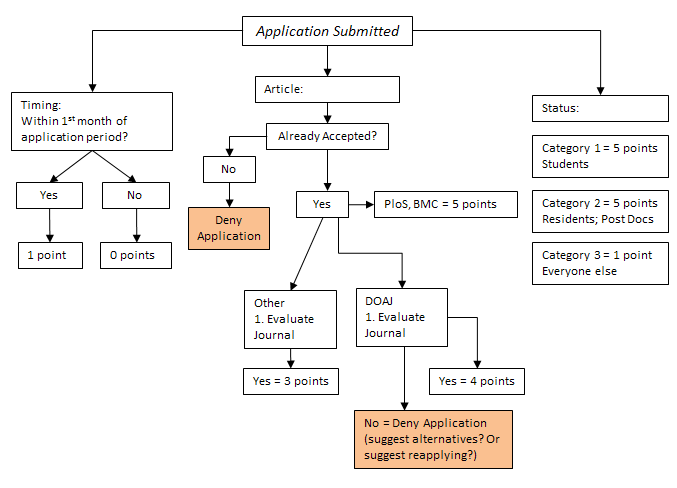 |
D-Lib Magazine
September/October 2014
Volume 20, Number 9/10
Table of Contents
The Role of a Digital Repository in a Library-Managed Open Access Fund Program
Heidi Zuniga
University of Colorado Anschutz Medical Campus
heidi.zuniga@ucdenver.edu
doi:10.1045/september2014-zuniga
Printer-friendly Version
Abstract
Developing partnerships between various library and campus programs or initiatives can be beneficial in today's digital information climate. This article discusses the development of an open access author fund at the University of Colorado Anschutz Medical Campus Health Sciences Library and the subsequent partnership with the library's digital repository, in which the articles supported by the fund were added to the repository. It also details the workflow used for tasks such as checking into copyright issues, issuing deposit agreements and handling paperwork and correspondences as part of the repository ingest process. The partnership resulted in benefits for the fund program, the repository, and the fund recipients.
Introduction
It is an interesting time for publishers and libraries alike as both are adapting to the rapidly changing digital information environment. One such change includes the growth in open access scholarly resources, which are freely available online to the public. Publishers of online open access (OA) journals are finding innovative ways to create new revenue streams because they do not charge subscription fees for access to their journals. One of the more popular approaches to solving the revenue issue is to require authors to pay a fee for having their articles published in OA journals. However, these fees can be significant and may be a barrier for authors who do not have the funds to cover the costs. Likewise, libraries are trying out different strategies to support OA, including building digital repositories, publishing or hosting local OA journals, linking to open access journals, and more recently, finding ways to help authors pay the publishing fees.
At the University of Colorado Anschutz Medical Campus Health Sciences Library, the library has completed the first round of a pilot program for which the library has developed and managed an OA author fund program (OA Fund). The program was considered to be successful and a second round of the program is currently in progress. The Health Sciences Library wanted to make the program beneficial for everyone involved, and so required recipients of the funds to agree to submit their articles to the library's digital repository, which is part of Digital Collections of Colorado. The intention of the collaboration was that the library would gain material for the repository and have an opportunity to support the scholarly activity of the campus while the authors would have a stable, open and findable place for their articles to reside now and in the future.
Basics of the OA Fund Program
Once the idea for the program gained traction and funds were identified to support the program, the library's pilot project team created a page on the library's website detailing the application process and eligibility requirements for the authors, as well as information about the fund amount and requirements for accepting the funds. They also utilized the library's various social media platforms to let potential applicants know about the program. As applications came in, the team kept track of the applicants, the article's publication stage and journal of publication on a spread sheet. At that point, journals were also evaluated for quality in order to avoid publishing in a questionable journal. Applications were evaluated using a point system, and through this system the team determined who would receive the award and the amount they would receive. Finally, the award winners were notified and the funds were dispersed if the article was already published or about to be published. If the article was still under review, the funding was held in reserve.

Figure 1: OA Fund Selection Criteria
Workflow for Adding Articles to Repository
Once all of the articles were published, a library staff member in the Collection Management department added the articles to the repository.
- The OA Fund team sent the articles to the digital repository staff. The repository staff verified which version of the article they received (pre-print, post-print, final post-publishing pdf).
- The author was asked to sign a deposit agreement. The agreement used at the Health Sciences Library can be emailed or it is available on the repository Springshare LibGuide. If there were multiple authors, the author was asked to obtain consent from the other authors if possible. The co-authors were permitted to indicate in an email that they agreed to add the article to the repository or they could also sign the deposit agreement. The lead author was permitted to sign the agreement on behalf of the other authors for OA articles if there was any difficulty in getting all authors' signatures.
- Repository staff checked the SHERPA/RoMEO site to get a sense of the journal or the publisher's policies on archiving or putting articles in an open access digital repository. Even if it was an open access journal, the publisher may only allow post-print or pre-print copies to be added to repositories, for example. This is why it was important to verify which version of the article the library had and to comply with the requirements of the publisher.
- If the publisher did not require specific permission but it was not clear upon investigation whether the publisher fully permitted articles to be added to digital repositories, repository staff would still email the publisher to try to get permission. By doing this, a reasonable effort to obtain permission to add the article to the repository had been demonstrated.
- The article, relevant emails, and all paperwork including the deposit agreement, SHERPA/RoMEO page, and publisher's consent were printed out and filed appropriately.
- All relevant emails were saved in a secure location.
- The repository staff member responsible for adding or "ingesting" files into the repository was sent the pdf of each article along with biographical information for each author. The staff member created metadata and added the article into DigiTool, which is the digital asset management tool used at the Health Sciences Library.
- Once the articles were in the repository, the authors were notified and provided with the persistent link to their articles as well as instructions on how to view usage statistics and how to find the social media sharing option in the DigiTool interface.
One Year Later
As the library completes its second round of the OA Fund, there has been time to evaluate the benefits of giving the digital repository a role in in the project. Indeed, other projects and programs are being considered for potential integration with the digital repository. One benefit, which is one the library hoped for, has been increased usage of the OA Fund articles in the repository, suggesting that the authors have had greater exposure for their articles through the repository. In addition to monitoring and providing usage statistics from the repository, the library is starting to provide altmetrics for articles, such as the badge of "donut" from Altmetric. Altmetric data shows an article's impact and usage beyond the usual citations and downloads by looking at social media, news, etc. The repository staff and the OA Fund Project organizers are looking at the possibility of adding the Altmetric badge directly into each article in the repository.
Another benefit that has resulted from this project is one that was not predicted. It was discovered that one of the OA Fund articles was the target of plagiarism. The article was altered slightly and republished through a non-reputable OA journal by someone who was not the author. The OA Fund author has been working to try and have the plagiarized article taken down. It has been helpful to be able to prove his article is the original one because it exists in the library's digital repository and includes dates that show his article was the first one published. Another potential benefit would be that the repository can act as a "safe deposit" box for articles if a journal ever ceases or the publisher shuts down. It is possible that an article, particularly an OA article, might only exist on the publisher's site if it was never added to an institutional repository as well.
The partnership with the OA Fund also provided the digital repository staff with a good opportunity to establish an effective workflow for depositing scholarly articles. Prior to that, the repository staff had mostly worked with material that did not require checking publishers' policies on copyright or open access digital repositories, so learning the best way to do that was valuable. Another positive result of working with the OA Fund was discovering that the deposit agreement needed to be fine-tuned to allow authors to sign on behalf of co-authors. This became necessary after finding it was sometimes very difficult to get each listed co-author to sign the agreement, particularly if the authors live in other countries and were not closely acquainted with one another. The deposit agreement was also amended to allow authors to type in their signature so they would not have to scan the agreement in order to submit a signed copy back to the library, which was proving to be an impediment. The only other obstacle the repository staff encountered was when authors did not return the deposit agreement. Fortunately, after several reminders, the authors eventually all signed.
The final yet ongoing task necessary for the success of this collaboration is marketing and outreach. The articles from the first round of the OA Fund have been in the repository for a long enough period of time to show that the articles are being read and cited. Marketing and outreach will be important to increase awareness of the OA Fund, of the repository and of OA resources in general. Even if members of the campus are more aware of these initiatives, it does not guarantee participation. Part of the outreach, therefore, will involve librarians increasing their awareness of what the needs of the campus are in terms of OA and how those needs can be met.
The repository will ideally become a growing, dynamic and useful part of the library, the campus, and the research community, not a dark cave where obscure items hibernate. Innovative partnerships with innovative programs may be one way to make sure the repository becomes indispensable. Hopefully the library's early experiences with the OA Fund and the repository can serve as a useful template for other libraries attempting to start similar programs. Perhaps one of the biggest lessons of all is that developing a symbiotic relationship at every level—between publishers, authors, the campus, the library and its repository—is one of the keys to surviving in a fast-changing open access publishing landscape.
References
Hicks, J., & Hoffecker, L. (2013, September). Open access to our open access fund. Poster presentation, MCMLA 2013, Salt Lake City, UT.
About the Author
 |
Heidi Zuniga is the digital resources librarian for the Health Sciences Library at the University of Colorado Anschutz Medical Campus where she manages electronic resources and the digital repository. She received her Bachelors and Masters in English at Pacific Lutheran University and Colorado State University and her MSLS from Clarion University of Pennsylvania. She worked as the electronic resources librarian at Ithaca College in Ithaca, NY prior to her current position.
|
|